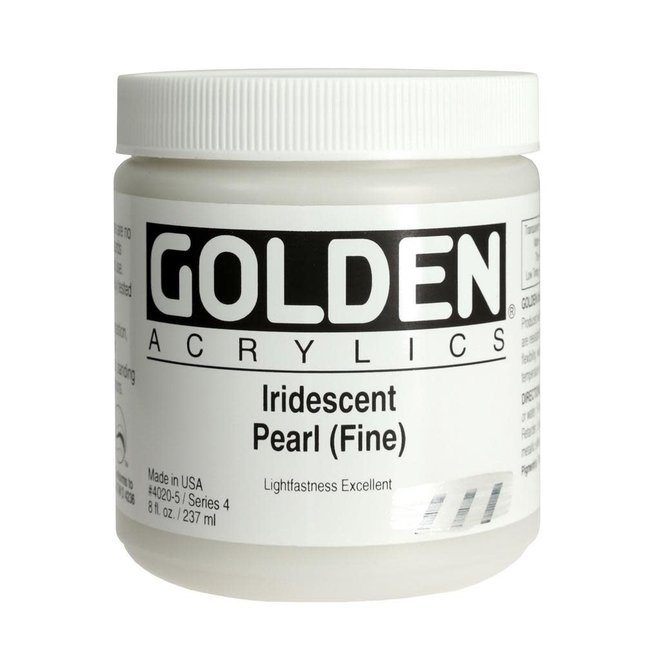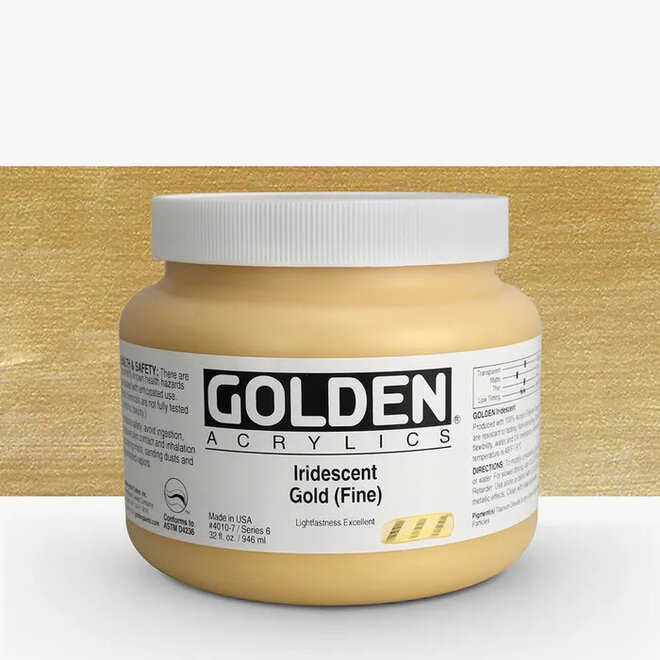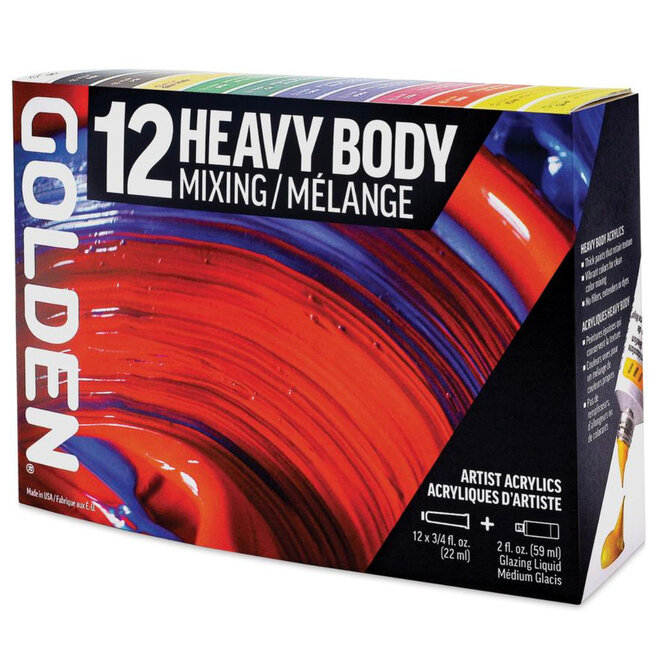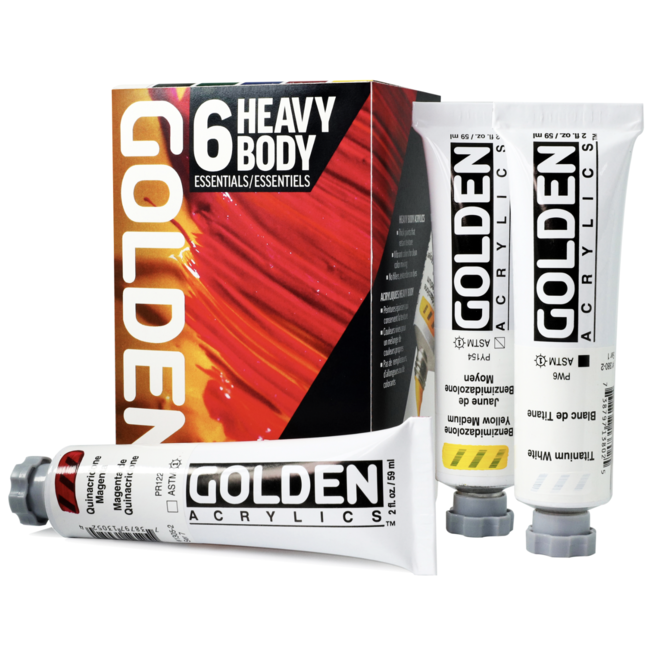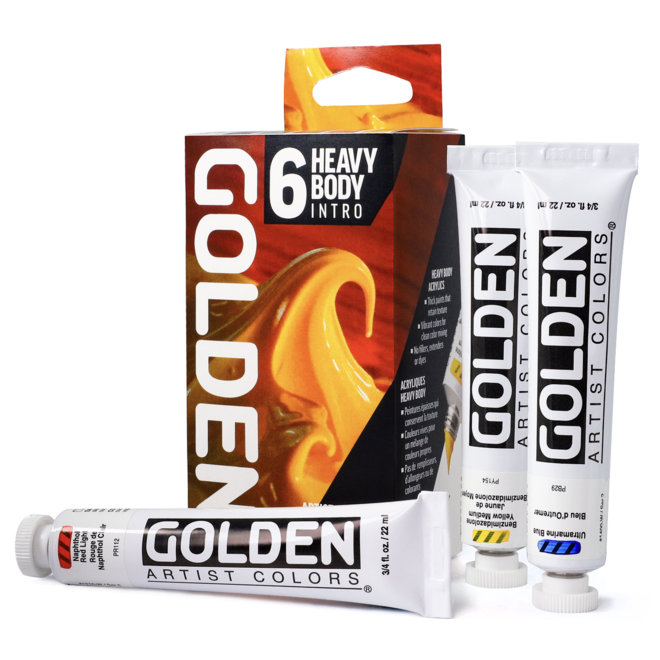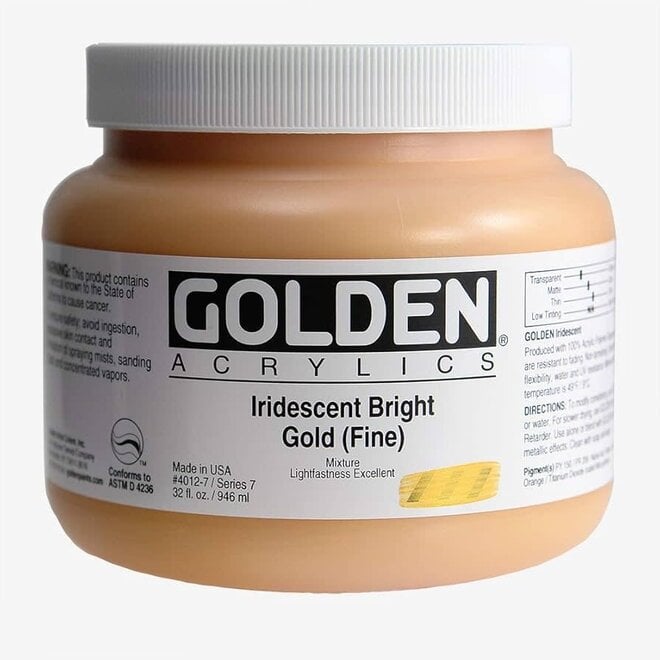HEAVY BODY ACRYLICS PRODUCT LINE HISTORY GOLDEN Heavy Body Acrylics were the first products introduced by Golden Artist Colors, Inc. in 1980. Initially, the Heavy Body line was sold directly to artists in Manhattan in quart and gallon containers. Pints, 8 oz. and 4 oz. jars soon followed as the products gained more and more popularity with professional artists. Tubes of GOLDEN Heavy Body Acrylics finally appeared on the market in 1990.
In 1980, it was considered unusual to contain a heavy body, high viscosity paint in a jar. Almost all of the literature written about acrylic at that time implied that jar colors were thin and tube colors were thicker. Actually, the first water-borne acrylic paint was thin - similar in consistency to house paint. Only after technological improvements allowed for thicker formulations could artist acrylics be put in tubes. Since GOLDEN began by directly supplying professional artists requesting quantities of paint, larger sized containers were preferred. As GOLDEN products became widely accessible, jars and tubes provided more size and packaging options for a growing group of artists with a variety of needs.
PRODUCT PROPERTIES Viscosity and Consistency GOLDEN Heavy Body Acrylics are noted for their exceptionally smooth, rich, buttery consistency. These paints have the ability to "stand up" and retain brush strokes or palette knife marks on the canvas.
All HB colors are thixotropic in nature. This means that when brushing or stirring, the paints actually lose viscosity and feel much thinner. The faster the paints are moving, the thinner they feel. Returned to a state of rest, the paints gradually increase in thickness until they are again restored to their formulated viscosity.
Film Flexibility The HB colors retain excellent flexibility when dry, greatly diminishing the possibility of cracking that occurs in other natural and synthetic polymer systems. The acrylics can absorb the constant stress and strain placed on canvas when shipped or as it expands and contracts with changes in temperature and humidity. Please note: acrylics begin to harden at 15 degrees Centigrade or 59 degrees Fahrenheit, and become quite hard at temperatures below freezing. This is especially important to remember when shipping a painting in freezing conditions or when unrolling a painting that has been kept in cold storage.
Product Mixing Abilities The HB Colors can be mixed with all of our GOLDEN Mediums, Gels and other paint lines, including our High Flow Acrylics, Fluid Acrylics, High Load Colors, Iridescent Colors, Paste Paints, and Matte Acrylics. By mixing paint lines, artists can produce a wide range of paint consistencies without compromising color strength. Heavy Body viscosity can also be reduced successfully with water. Remember: the more water added to the acrylics, the greater the subsequent shrinking of the paint layer. Too much water will reduce the binding capability of acrylic paints and tends to flatten out their sheen.
Some artists have used other solvents, including alcohols, to thin the HB Acrylics. All of the acrylics are sensitive to additions of solvent. If you require this addition it is advisable to dilute the solvent first with water to reduce the shocking effect of the solvent. In some cases, adding solvent too quickly will coagulate the acrylic.
Blending with Mediums The GOLDEN fluid mediums, including Polymer Medium, Acrylic Glazing Liquid, the GAC Mediums and the Airbrush Mediums, can be used to thin Heavy Body Acrylics. They also add a myriad of unique possibilities to the working and gloss properties of the paint surface. All GOLDEN mediums retain the film integrity of the acrylic, and in some cases they actually enhance the durability of the paint film. (Refer to Gels & Mediums Product Review for more information).
Product Gloss Variations When producing the HB line, GOLDEN consciously broke the mold of the acrylics made in the past. Most acrylics were produced to have an even satin sheen across the range of colors. Manufacturers felt artists wanted this even sheen to avoid the differences encountered by oils. In Oils, the colors requiring very little oil (lean colors) tended to be very matte, while those colors requiring substantial amounts of oil (fatty colors) tended to be quite glossy.
GOLDEN decided not to add the flattening agents typically added to acrylic paints to unify the product"s finish. We decided that each pigment would be made to its own level of matte or gloss depending upon its own unique nature. We also decided not to add opacifiers to our colors (use of opacifiers is critical for coverage of house paints, yet it is also the reason that house colors tend to be quite subdued compared to professional artist colors). These decisions allowed our colors to retain their clearest and cleanest quality, especially when used in washes or glazes. It is always possible to add matting agents and other whitening materials to the product, but once added, it is impossible to take them away. The HB line of acrylics contains no additional flattening agents, opacifiers or other solids that might interfere with the clarity of our pigments.
It is quite evident when looking at our color chart that colors in the HB line do differ in gloss. For example, the sheen of GOLDEN Ultramarine Blue or Burnt Umber is almost a dead matte, whereas the sheen of Green Gold or Dioxazine Purple is extremely glossy. Some artists may find this problematic; yet for many artists the variations offer the same nuances of color that are so appreciated in oil paints and give what many describe as an organic look to the colors. Without the need for opacifiers we can offer colors as similar in hue as the Cadmiums and Hansas, yet quite different in their ability to cover and in their clarity when mixing.
GOLDEN Heavy Body Matte Acrylic Line The sheen of the HB acrylics can be altered with gels, mediums or varnishes. However, for those artists looking for a paint line with uniform matte finish, GOLDEN offers the Matte Acrylics. The Matte Heavy Body Acrylics are essentially the same as the regular Heavy Bodies, except matting agents are added to glossier colors.
COLOR RANGE The Main Set of Colors Probably the biggest standout of our ever-expanding Heavy Body line is the breadth of unique colorants we offer. The line currently consists of 73 colors, 7 Neutral Grays, 3 Primaries, 7 Historical Colors and 11 Custom Colors for a total of 101 different colors, shades and tints. Only about 30 of these colors are mixture colors, while the rest of the Heavy Body line is produced from single, unique pigments.
Mixture Colors The mixture colors within the GOLDEN HB line of acrylics include Green Gold, Jenkins Green, Quinacridone Crimson and Turquois (Phthalo), as well as our Neutral Grays, Historical Colors, Blended Colors and Primaries. Some mixture colors, such as GOLDEN Historical Colors, offer safe and lightfast alternatives for pigments that, otherwise, would be dangerous or insufficiently light stable for artist use.
The Neutral Gray Set The Neutral Grays in the HB line are a series of achromatic grays. Achromatic grays allow artists to adjust the value or chroma of a paint color without altering the color"s hue. When using a Neutral Gray of the same value as the color selected, the artist will be able to change only the chroma (intensity) of a certain color, while maintaining the hue and value. Mixing a Neutral Gray with a color of a different value will change both value and intensity.
The Neutral Grays follow the Munsell Value Scale, (a scale ranging from black to white), through a progression of light to dark grays. The Munsell scale defines black as N1 and white as N10. We recommend using GOLDEN Bone Black as the neutral black (equivalent to Munsell notation N1), and using Titanium White as the neutral white (N10). GOLDEN Neutral Grays include the values N2, N3, N4, N5, N6, N7, and N8. These grays are very carefully formulated to be evenly spaced and completely achromatic. Using a spectrophotometer, we carefully monitor the production of each batch to be certain that they fall within a very tight tolerance range. (Refer to the Neutral Gray Information Sheet for more information).
The Primary Set GOLDEN Primary Cyan, Magenta and Yellow in the HB line should be of special interest to artists who want a totally pared down palette or who are in need of a tool for teaching about color mixing and blending. They have been formulated to be close in color strength, so that one hue will not predominate over the other colors. The mixture of these products will produce an incredibly rich and infinitely varied wheel of color.
The Blends Finally within the HB line of products is our line of Blended Colors. The Blended Colors are mixture colors which many artists find convenient in assisting with the color mixing process. They include a range of bright Greens, Blues, Violets and Reds. The line of Custom Colors also includes a range of Cadmium Hues and a Cobalt Hue for those artists who want the shade of a Cadmium or Cobalt, yet are either concerned about the cost or the safety of the material.
PIGMENT SELECTION The HB line is divided among inorganic and organic pigments.
Inorganic Pigments Some inorganic pigments have been around for centuries and some for millennia. They are produced either with naturally mined pigments (sienna, umber, ochre) or with synthetically manufactured pigments, (iron oxide, carbon black, etc). Inorganic pigments may also be produced using a combination of these two processes. Pigments that are both mined and manufactured include the Cadmiums, Cobalts, and Titaniums.
Organic Pigments The organic pigments are a group of colors that are synthetically produced through complex carbon-containing chemistry involving various materials including petroleum, coal tar and natural gas. Many of these pigments have their roots in the chemistry of the 1800's, although widespread production didn't really begin until the 1930's. Even though they have only been available for several decades, organic pigments have demonstrated remarkable abilities to withstand the impact of light and weather.
Pigment Selection & ASTM Standards Every color within the HB Line is approved for professional artist use according to ASTM Standards for Artist Materials. These standards regulate paint consistency and demand fineness and lightfastness of chosen pigments, use of 100% acrylic binder, freeze-thaw stability, and accuracy of labeling for pigments used. Evaluation by an approved toxicologist is required.
Of the 101 HB colors, 94 within the line are considered excellent in lightfastness (the ability to withstand color change due to exposure to light). The remaining 7 are rated very good for lightfastness. GOLDEN does not use any colors within the HB line rated less than very good. Those colors rated as very good include the two Naphthols, Hansa Yellow Light, Permanent Green Light, Dioxazine Purple, Green Gold, and Primary Yellow. It should be noted that of the colors rated as excellent in lightfastness, the Cadmium colors are especially sensitive to the combination of light and moisture, so outdoor use of these colors should be avoided.
PIGMENT FAMILIES The Quinacridone Family There are more Quinacridones in the GOLDEN HB line than in any other acrylic line of paint. Quinacridone pigments produce seven intense colors ranging from deep yellow to vibrant violet. All of the Quinacridones, because of their vibrant undertones and high transparencies, tend to be excellent mixing colors. They tend not to muddy or gray, retaining their brightness.
Perhaps the most important GOLDEN Quinacridone color is Quinacridone Crimson, a color with excellent lightfastness and similar working qualities to the more fugitive Alizarin Crimson. GOLDEN Quinacridone Crimson possesses the deep burgundy mass tone as well as the bright, rosy undertone of traditional Alizarin. GOLDEN's Quinacridone Crimson has been used by conservation professionals to replace the fugitive Alizarin when restoring paintings. Like all of GOLDEN's Quinacridones, Quinacridone Crimson is exceptionally transparent and works particularly well as a mixing color. Mixing Quinacridone Crimson with Phthalo Green B/S will almost magically produce one of the deepest blacks imaginable.
Unique to GOLDEN's product line are the standout colors Quinacridone/Nickel Azo Gold and Quinacridone Burnt Orange. These Quinacridones have a luminosity that rivals the richest oil colors. Their mass tones tend to be quite dark, yet their undertones are incredibly vibrant. Quinacridone/Nickel Azo Gold looks very close to a Burnt Sienna in its mass tone, yet its undertone has a yellow fire not found in any Sienna. Similarly, Quinacridone Burnt Orange has a brown-red mass tone that reveals a brilliant red orange underneath.
Quinacridone Red is GOLDEN's recommendation when a very intense mixing magenta primary is requested. It is very close in hue to the color gels produced by Kodak for primary magenta at 5500 Kelvin. Quinacridone Magenta and Violet tend to be excellent choices for mixing colors in the lavender through purple range, with the addition of various transparent blues. Quinacridone Red, Red Lt. , Magenta and Violet produce high intensity pinks through lavenders when mixed with white. GOLDEN recommends using these colors when a punch of a fuchsia or fluorescent color is needed, yet permanency is also required, for a particular work of art.
The Cadmium Family The second largest pigment family within GOLDEN's HB line is the Cadmium family. GOLDEN was the first company to introduce concentrated Cadmiums within an acrylic line. Before this occurred, other acrylic paint companies were using less expensive Cadmiums co-precipitated with Barium Sulfate.
The Cadmiums range in hue from the glowingly bright Cadmium Yellow Primrose to Cadmium Red Dark. As a class of pigments, the Cadmiums are some of the most opaque of all colorants. Additionally, within their hue range they provide some of the most intensely vibrant mass tones. Because of their opacity, when mixed with other colorants they tend to produce rather dull hues. Cadmiums do mix with other Cadmiums quite well, however. Mixing a Cadmium Orange with a Cadmium Yellow will produce a deep yellow or light orange and the mixtures will retain the brightness of a pure Cadmium color.
GOLDEN is one of the only acrylic manufacturers to include a yellow hue that is lighter than the typical Cadmium Yellow Light. This unique pigment called Cadmium Yellow Primrose is as bright as some fluorescent colors, yet offers the same stability as the other Cadmiums in the GOLDEN line.
Cadmiums have been considered somewhat controversial as a pigment class because of the claims of toxicity of the pigment. We do know that soluble Cadmium can be quite dangerous and produce heavy metal poisoning. All of the Cadmiums used within our product line have gone through extensive testing to assure that they have extremely low soluble Cadmium content. This is not the end of the controversy though, since more recent theories have suggested that even non-soluble Cadmium pigments could potentially be toxic. OSHA has created strict requirements for work environments where Cadmium pigments are being used. This is of extreme importance legally for artists, schools or any business that hires other employees or is responsible for public safety. If you are using Cadmium dry pigments within your work process, you are not, according to the new OSHA regulations, within allowable limits of exposure for yourself and those within your care.
The Phthalocyanine Family The Phthalocyanines are known as the oldest organic pigments. The GOLDEN HB line contains 5 Phthalocyanine colors, including Phthalo Green (Yellow Shade) and Phthalo Green (Blue Shade), Turquois (Phthalo), and two Phthalo Blues, (Green Shade) and (Red Shade). These different Phthalocyanine colors actually contain the various pigment forms of the Phthalocyanine group.
The Cobalt Family The Cobalt pigments are unique within the HB line. This range of 7 colors includes Cerulean Blue and Blue Deep (these contain both Cobalt and Chromium), Cobalt Blue, Cobalt Green, Cobalt Titanate Green, Cobalt Turquois, and the newest addition, Cobalt Teal. Cobalt Teal is an unusually clean and high chroma shade that possesses excellent lightfastness and opacity.
The Pyrrole Family The Pyrrole family is one of the newer pigment families to be developed. The Pyrroles are almost as opaque and, in fact, brighter than our Cadmium colors. Pyrrole Orange, Pyrrole Red Light, and Pyrrole Red exhibit excellent opacity and lightfastness. They also offer clean mixing with other organics, unlike their Cadmium counterparts, which produce muddier blends.
Disclaimer The above information is based on research and testing done by Golden Artist Colors, Inc., and is provided as a basis for understanding the potential uses of the products mentioned. Due to the numerous variables in methods, materials and conditions of producing art, Golden Artist Colors, Inc. cannot be sure the product will be right for you. Therefore, we urge product users to test each application to ensure all individual project requirements are met. While we believe the above information is accurate, WE MAKE NO EXPRESS OR IMPLIED WARRANTIES OF MERCHANTABILITY OR FITNESS FOR A PARTICULAR PURPOSE, and we shall in no event be liable for any damages (indirect, consequential, or otherwise) that may occur as a result of a product application.


